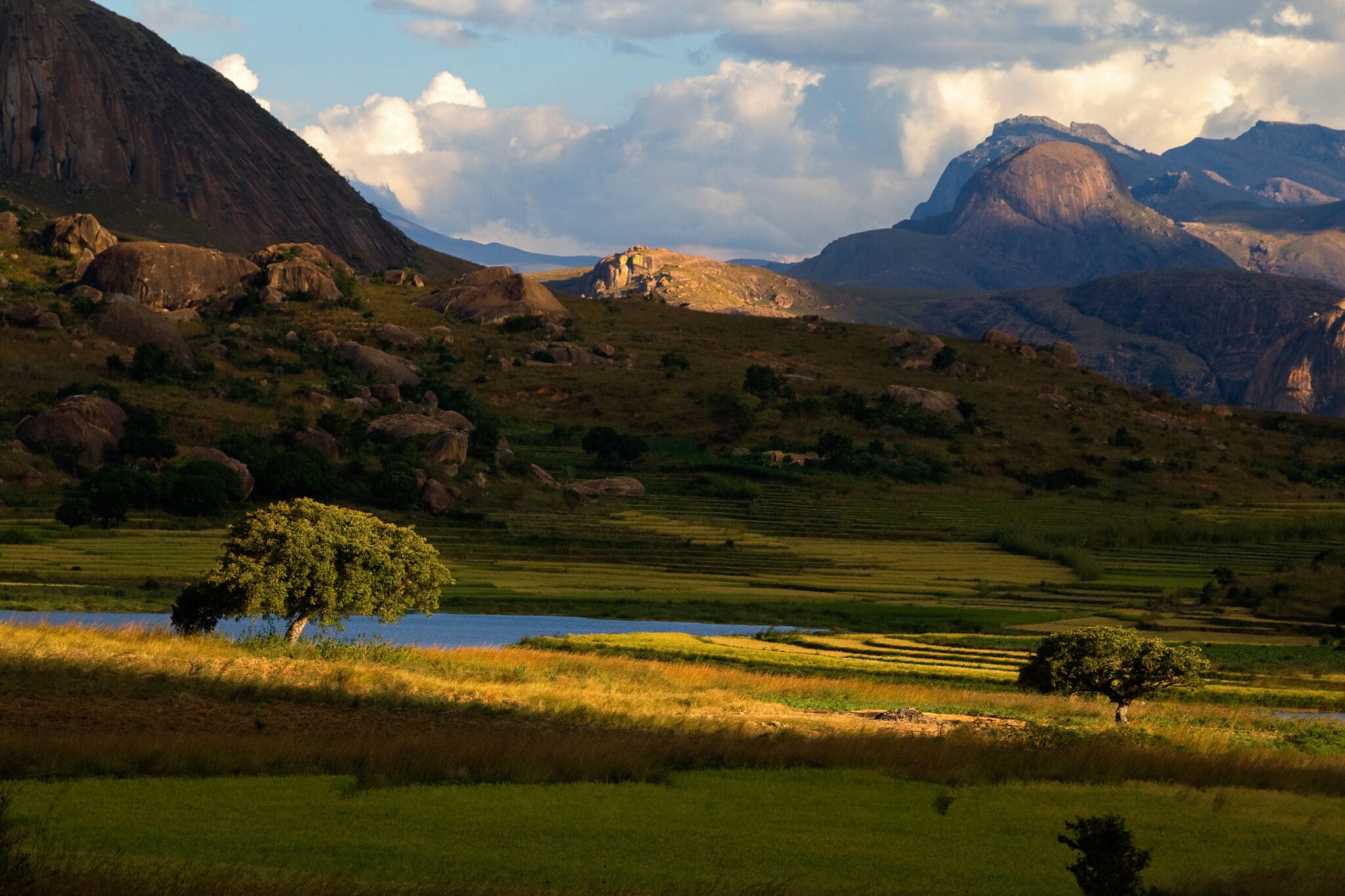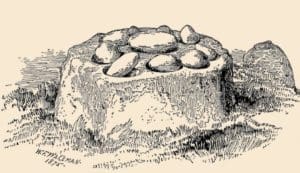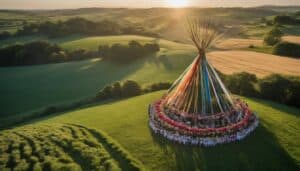Unmasking the Mysterious Island of Madagascar

Updated On: April 23, 2024 by Noha Basiouny
Imagine an island sculpted by time itself, where ancient baobab trees dance like giants under sapphire skies and mischievous lemurs flit through emerald rainforests. This is Madagascar, a land cradled in the turquoise embrace of the Indian Ocean off the coast of Africa.
Yet, despite its proximity, Madagascar’s landscapes whisper of isolation, echoing with the secrets of 165 million years spent adrift from the cradle of continents. This isolation gave birth to a symphony of biodiversity, where over 80% of its plants and animals exist nowhere else on Earth. This island is genuinely such a canvas painted with raw, untamed beauty.
So, whether you seek a wildlife safari led by playful primates, a trek through verdant jungles echoing with ancient songs, or a sun-kissed escape to beaches where time melts into the azure horizon, Madagascar beckons. Come explore the island and prepare to be captivated by a land where reality surrenders to the extraordinary. This is Madagascar, whose siren song will forever resonate in your soul.
Madagascar
Madagascar is an island country located in the Indian Ocean, about 400 kilometres off the southeastern coast of Africa. It is the fourth largest island on the planet after the amazing Greenland, New Guinea, and Borneo, with an area of 587,041 square kilometres. It has a population of 28.8 million people who speak two official languages, Malagasy and French.
While there are smaller islets and islands off the coast of Madagascar, the main island is the largest and most significant part of the country.
The largest city and capital of Madagascar is Antananarivo, or Tana for short, and is nicknamed the “City of a Thousand Warriors”. It is located in the central highlands of the country and serves as its political, economic, cultural, and administrative centre at an incredible 1,276 metres above sea level. This is beside over 50 other prominent cities scattered around the island.
For over 50 years, Madagascar had been a French colony before it declared independence in 1960. The country has faced challenges such as political instability, economic struggles, and environmental issues, yet it has still remained a fascinating and ecologically significant destination.
One of the many impressive things about Madagascar is its unique biodiversity, with a high percentage of endemic plant and animal species that are not found anywhere else on Earth, and the reason for such uniqueness has to do with the island’s initial formation.
As it turned out, what we now know as South America, Africa, frozen Antarctica, Australia, Madagascar, the Indian subcontinent, and the Arabian Peninsula used to be one super colossal landmass called Gondwana some 185 million years ago. At some moment in time and for many reasons that geologists could happily explain in a week-long lecture, the eastern part of this supercontinent, comprising Madagascar, the Indian subcontinent, Australia and Antarctica, separated.
Some million years later, Madagascar and the Indian subcontinent, then still attached, separated from Australia and Antarctica, and then Madagascar separated for the last time about 85 million years ago. Since then, it has been mindlessly drifting in the Indian Ocean.
According to scientists, these consecutive separations, followed by the island’s eternal isolation, provided a relatively stable environment for species to evolve independently and allowed for the preservation of ancient lineages and the evolution of species that resemble their ancestors.
The island features a variety of ecosystems, including rainforests, dry forests, highland plateaus, and unique spiny forests. This diverse range of habitats has led to the evolution of species adapted to specific ecological niches.
Weather
Thanks to its geographical location south of the equator and diverse topography, Madagascar experiences a tropical climate featuring distinct wet and dry seasons.
The wet season typically falls between November and April, with the peak of rainfall between January and March. During this period, the eastern side of the island, including areas like Antananarivo and the eastern rainforests, receives heavy rainfall. Cyclones are also a possibility, particularly in the coastal regions.
The dry season, on the other hand, runs from May to October. This period is characterised by cooler temperatures and lower humidity. The western and southern regions are drier during this time.
Speaking of temperatures, Madagascar is generally warm throughout the year. Coastal areas have warmer temperatures, while the central highlands, including Antananarivo, can be cooler due to their higher altitude. The average coastal temperatures range from 25°C to 30°C, while the central highlands may have average temperatures between 15°C to 25°C.
Brief History
The history of Madagascar is marked by a blend of indigenous cultures, maritime influences, and European colonialism.
The island of Madagascar was likely first settled by Austronesian-speaking people from Southeast Asia, possibly around 2000 years ago. Over time, these settlers developed distinct cultures and languages. Over the years, trade and cultural contacts between Madagascar and the African mainland, as well as Arabian traders, influenced the island’s development. Bantu-speaking communities from West-Central Africa also migrated to Madagascar during this period.
In the early 16th century, Portuguese explorers were the first Europeans to ever make contact with Madagascar. By the 17th century, several Malagasy kingdoms had emerged. The Merina Kingdom, founded in the central highlands, became dominant under King Andriamasinavalona. His successor, King Radama I, sought to unify the island and establish trade with European powers.
Yet, some of those European powers apparently came to the island to stay. In 1885, the French established a formal protectorate over Madagascar, and the island became a French colony in 1897. It was not until 1960 that the island was declared independent after over a decade of resistance and violence from the Magalasy. The First Republic was then established, and Philibert Tsiranana became the country’s first president.
Experiencing ‘republicness’ for the first time, Madagascar did go through periods of political instability, including changes in government, economic challenges, and social issues. In 1975, Admiral Didier Ratsiraka came to power in a socialist revolution, leading to the establishment of the Democratic Republic of Madagascar. In the 1990s, several political reforms were made, marking a shift towards a multi-party democracy and the presidency changed hands through democratic elections.
Biodiversity

Madagascar is often called the “eighth continent,” with an exceptionally rich and uniquely captivating biodiversity characterised by a large number of endemic species that make it a global hotspot for conservation and a haven for those seeking a glimpse into evolutionary marvels.
The most iconic inhabitants of Madagascar are the lemurs, a diverse group of primates that evolved in isolation over millions of years, as we mentioned earlier, so they are only found on this island. They are characterised by their large eyes, distinctive faces, vibrant fur colours, and long tails. They are not only a symbol of Madagascar but also a crucial element in its delicate ecological balance.
Beyond lemurs, the island’s biodiversity extends to a myriad of other endemic species.
Chameleons showcase an astonishing array of colours and possess remarkable camouflaging abilities, while the fossa, resembling a mix between a mongoose and a cat, is the island’s top predator and the one that preys upon pretty much all lemur species—Mufasa said it is the Circle of Life so do not feel sad about it.
In addition to those, as well as other animals, Madagascar is rich in bird species, many of which are endemic, too, such as the Madagascar pochard and the Madagascar fish eagle.
The island is also home to several species of the iconic baobab trees that are known for their distinctive appearance, characterised by thick, swollen trunks and often referred to as the “upside-down trees.”
Two species of baobabs are endemic to Madagascar. The most famous is Grandidier’s Baobab, renowned for its enormous trunk and branches that resemble gnarled roots, creating a striking silhouette against the Madagascar landscape. The other species is the Suarez Baobab, found in the northern part of the island and distinct for its bottle-shaped trunk, reaching up to 25 metres in height and two metres in diameter.
It does not even stop here. Madagascar is where humpback whales can be spotted. During the austral winter, from June to September, these gigantic marine mammals are often found in the warm waters off the coast of Madagascar for breeding and calving. The northeastern coast of the island is a popular spot for whale watching.
Madagascar’s commitment to marine conservation and sustainable tourism has contributed to efforts to protect these majestic animals and their habitats.
Whale-watching tours are often organised by local operators, allowing tourists to observe these incredible creatures in their natural environment while promoting responsible and respectful interactions.
National Parks and Reserves
Madagascar’s ecological riches are safeguarded within a network of captivating national parks and reserves, each offering a unique window into the island’s extraordinary biodiversity.
There are 19 officially designated national parks managed by Madagascar National Parks (MNP), as well as 21 special reserves and two official marine reserves. These protected areas not only serve as crucial habitats for the isand’s countless endemic species but also provide a sanctuary for nature enthusiasts and conservationists alike.
So, let’s explore some of those.
1. Andasibe-Mantadia National Park

Andasibe-Mantadia National Park is situated in eastern Madagascar, approximately 150 kilometres east of Antananarivo and covers a total land area of roughly 155 square kilometres. The park has two main sections: Andasibe Special Reserve—also known as Perinet Reserve—and Mantadia National Park. Each section has its own unique features and ecosystems, contributing to the overall biodiversity and conservation efforts of the region.
The park features lush rainforests, crystal-clear streams, and diverse landscapes ranging from primary rainforest to highland forest. The terrain is characterised by hills and valleys, creating a scenic environment for visitors.
Speaking of residents, Andasibe-Mantadia is famous for its lemur populations, including the critically endangered Indri, the largest living lemur species. Other lemurs found in the park include the Diademed Sifaka, Eastern Woolly Lemur, and Black-and-White Ruffed Lemur.
Andasibe-Mantadia is also a birdwatcher’s paradise, with a high diversity of bird species. Notable birds include the Madagascar Blue Pigeon, the Madagascar Long-eared Owl, and several species of vangas.
2. Isalo National Park

In the southwestern part of the island lies the mesmerising Isalo National Park, a protected area characterised by stunning landscapes dominated by eroded sandstone formations, deep canyons, and high plateaus. The park’s terrain includes natural pools and lush vegetation, creating a visually striking and diverse environment.
Isalo National Park is also home to several lemur species, including the ring-tailed lemur and Verreaux’s sifaka. It supports a variety of plant species adapted to the arid climate, including endemic succulents and unique vegetation, in addition to bird species and reptiles, like the chameleon.
The unique landscapes and geological features of the Isalo National Park make it a notable destination for ecotourism, attracting visitors interested in hiking, nature photography, and experiencing the distinct beauty of southwestern Madagascar. To boast this, the park offers a network of well-marked hiking trails, including routes to the Canyon des Singes (Monkey Canyon) and the Piscine Naturelle (Natural Pool).
3. Ranomafana National Park

Ranomafana National Park is nestled in the southeastern part of Madagascar, around 375 kilometres away from Isalo National Park. The name “Ranomafana” translates to “hot water” in Malagasy, and it was given to the park thanks to its thermal springs. Known for its rich biodiversity, lush rainforests, and diverse ecosystems, the park was established in 1991 to protect the critically endangered golden bamboo lemur discovered in the area in 1986.
Besides those, the park is home to the red-bellied lemur, greater bamboo lemur, and Milne-Edwards sifaka and supports numerous bird species, reptiles, amphibians, and a wide array of plant life.
The park features diverse vegetation, ranging from lowland rainforest to montane forest. There are various types of orchids, ferns, and medicinal plants contributing to the overall biodiversity of the region.
Ranomafana offers well-maintained hiking trails that allow visitors to explore its diverse landscapes. Guided walks provide opportunities to spot lemurs, birds, and other wildlife while learning about the park’s ecology and conservation efforts.
The park has been a focus for research on Madagascar’s biodiversity and has contributed valuable information for conservation efforts. It is part of the Rainforests of the Atsinanana and a UNESCO World Heritage Site.
4. Tsimanampetsotsa National Park
Another fantastic national park is Tsimanampetsotsa National Park—there is absolutely no use trying to pronounce it, so let it go—located in the southwestern part of the island. It is centred around Lake Tsimanampetsotsa, a shallow, alkaline lake with high salinity that supports a unique ecosystem and serves as a breeding site for flamingos.
Due to the presence of this lake, the Tsimanampetsotsa Park was designated as a Ramsar Wetland of International Importance.
The park features limestone plateaus with impressive geological formations, including sinkholes and caves. The limestone landscapes contribute to the overall biodiversity of the region.
Like the other parks, the Tsimanampetsotsa Park is home to various species of lemurs, reptiles, and endemic birds, with some notable species including the critically endangered Madagascar fish eagle, the white-footed sportive lemur, and the ring-tailed mongoose. The park also showcases a variety of plant life adapted to the arid conditions, including spiny and succulent vegetation.
Historical Sites and Landmarks
Madagascar has a rich history, and there are several historical sites and landmarks that reflect its diverse cultural heritage. Here are some of its notable historical sites.
The Rova of Antananarivo, located in the capital city, served as the royal palace for the Merina Kingdom. It includes the Queen’s Palace, the King’s Palace, and other structures.
Situated in Antananarivo, the Andafiavaratra Palace, a true architectural masterpiece, was the residence of Prime Minister Rainilaiarivony during the late 19th century. Today, it is a museum showcasing the history of Madagascar.
Near Antananarivo, there is the Royal Hill of Ambohimanga, a UNESCO World Heritage Site and a fortress that was a key stronghold for the Merina Kingdom. It is also considered sacred, for it includes tombs of Merina monarchs, providing insights into the kingdom’s history and burial practices.
The Île Sainte-Marie, also known as Nosy Boraha, is a stunning island situated off the northeast coast of Madagascar. During the 17th and 18th centuries in particular, it became a notorious haven for pirates, who were known to use the island as a base for their operations. The Pirate Cemetery is a notable site on the island where some of the tombstones of pirates and privateers can be found.
The island is a stunning vacation spot, boasting turquoise waters with vibrant coral reefs and colourful marine life, pristine beaches fringed with palm trees, and lush green interiors—a true tropical paradise, we should say.
Besides the island, Madagascar boasts an array of stunning beaches such as Anakao, located in the southwest of Madagascar; Ifaty, Ramena, which is situated in the far north of the island; and Salary Bay that is near Ramena.
All those stunning beaches offer various marine activities, including snorkelling, diving, and boat trips. Between June and September, they transform into a prime destination for whale watching as they come breach, play and migrate along the coast of the island.
Vanilla
Thanks to its fertile soil and tropical climate, both combined with specific cultivation techniques, Madagascar boasts vanilla production. In fact, the island is the largest producer of vanilla beans in the world, high-quality vanilla beans, mind you, with 2,975 tonnes in 2020. This made up 39.1% of the global vanilla production that year.
More elaborately, Madagascar produces Bourbon vanilla, a term that originally referred to the Indian Ocean’s Bourbon Islands, where the vanilla orchid was introduced. The Bourbon vanilla variety is known for its rich and creamy flavour profile, making it highly desirable in the global market.
Madagascar exports a substantial amount of vanilla to various countries around the world. The island’s vanilla industry plays a crucial role in its economy, and the export of vanilla contributes significantly to its international trade.
However, life is not always a bowl of cherries, and the vanilla industry in Madagascar happens to be facing some challenges. These typically include fluctuations in prices, issues related to sustainable farming practices, inadequate infrastructure, difficulties in transporting the delicate vanilla beans from remote regions to processing centres, unpredictable weather patterns, cyclones, and extreme climatic events as well as political instability.
Efforts have been made to overcome these issues, starting with strengthening the entire vanilla value chain, from production to processing and marketing, promoting sustainable vanilla farming practices, educating farmers on optimal cultivation methods, and creating mechanisms to ensure fair pricing and transparency in the vanilla market.
Madagascar’s story is far from over. Yet, amidst the whispers of enchanting lemurs and the vibrant rhythm of traditional music, there is a resounding message: Madagascar is a land of endless discovery, a tapestry woven from ancient magic and unwavering human spirit.
So, whether you are drawn by its otherworldly landscapes or the warmth of its people, let Madagascar ignite your curiosity. Embrace the adventure, delve deeper into its secrets, and lend your voice to its future. The island where lemurs swing through the trees, baobabs stand as ancient sentinels, and the Indian Ocean caresses shores both remote and inviting awaits, ready to captivate your heart and inspire your soul.






